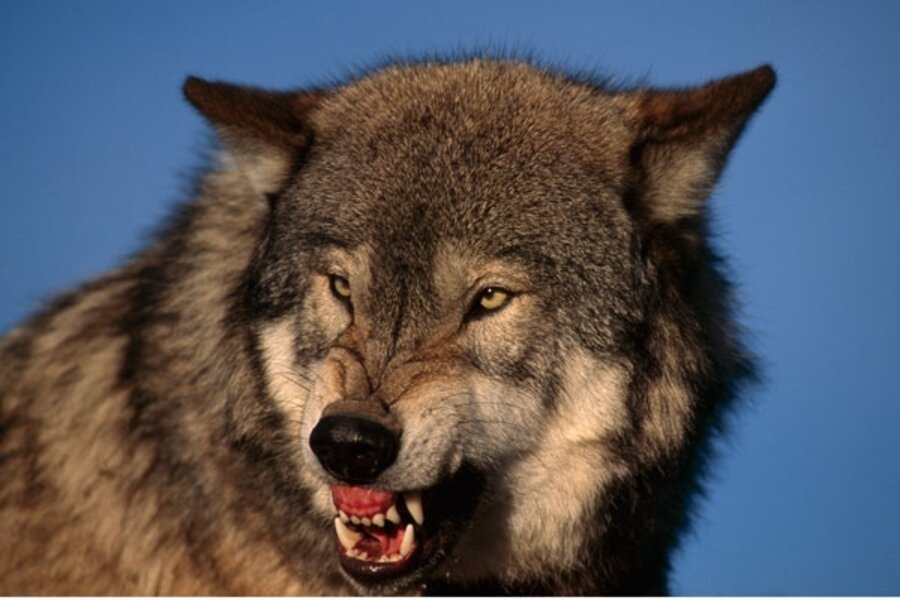The gray wolf heads back to court
Loading...
It's one of those wildlife stories where hardly anyone involved ends up happy with the outcome. And these days, that generally means lawsuits.
Almost extinct in 1974 when it was placed on the endangered species list, the Rocky Mountain gray wolf has made such a comeback, says the US Fish & Wildlife Service (FWS), that it was officially delisted earlier this week (except for Wyoming, where it remains a protected species – more on this in a minute).
The FWS is happy because the gray wolf population has recovered. "Currently, there are at least 1,645 wolves in the NRM [Northern Rocky Mountains] living in about 217 packs," it reports.
But ranchers and farmers aren't thrilled, to say the least, by an increase in gray wolves in their region. Their feelings of many are summed up in an opinion piece by Bill Moore at OregonLive.com, Wolves: Ranchers deserve to protect their property.
According to the FWS's figures: "Since 1987, confirmed kills by wolves total 1,109 cattle, 2,133 sheep, 115 dogs, 21 llamas, 28 goats, and 10 horses," and the "rate of kill" is increasing, although the level is lower than predicted.
But many environmentalists also aren't happy that gray wolves are no longer protected by the endangered species list (the delisting upheld a last-minute decision by the Bush administration). The announcement by the Interior Department "drew protests, including a letter signed by 225 scientists, saying the wolf population hadn't grown large enough," says SFGate.
Groups such as the Natural Resources Defense Council say that the wolves are going unprotected too soon. “Last time the [Fish & Wildlife] Service removed legal protections, there was an all out war on wolves in the weeks that followed,” said Louisa Willcox, director of the NRDC’s office in Livingston, Mont. “We are so incredibly close to fulfilling the conditions necessary to declare the wolves’ comeback as complete, but this move threatens to undo what should be an incredible conservation success story.”
CommonDreams.org reports this comment from Suzanne Stone, Northern Rockies representative for Defenders of Wildlife:
"All the reasons why this plan was a bad idea when the Bush administration proposed it still stand today. Idaho, which hosts the majority of the region's wolf population, has already publically announced its desire to aggressively reduce its state wolf population once federal protections are lifted. Today, there are at least 25 packs on the short-list that may be targeted for removal. ... Delisting the wolf at this point in time completely undermines the serious work, consideration and cooperation among all stakeholders that is necessary before being able to objectively declare the gray wolf recovered."
So a group of 12 environmental groups plans to sue Interior Secretary Ken Salazar to return the gray wolf to the endangered species list. Something similar happened two years ago when a trio of animal-advocacy groups – The Humane Society of the United States, Help Our Wolves Live, and the Animal Protection Institute – sued the FWS to prevent it from removing the wolves from gray wolves from the endangered species list in Minnesota, Wisconsin, and Michigan.
(Brad Knickerbocker provides some excellent background on this ongoing saga in a 2008 Monitor article.)
Add Wyoming to the list of those filing lawsuits. The gray wolf remains federally protected in Wyoming because, the FWS says, the state lacks a management plan it considers appropriate.
The Associated Press reports what that means: The service "rejected the state's plan for a 'predator zone' where wolves could be shot on sight. Wyoming Gov. Dave Freudenthal and a coalition of livestock and hunting groups have announced a lawsuit against the federal government over the decision."
A Wyoming newspaper article suggests that Wyoming's status could hurt its ranchers when dealing with predator wolves.
Feelings run strong on both sides:
"Wanna Shoot a Wolf? Come to Idaho," shouts Mother Jones magazine.
"Idaho Governor C.L. Butch Otter repeated his wish to be the first in his state to get the wolf hunting tag so he can try to shoot one of the wolves," says RedOrbit. " 'The fish and game population is really counting on a robust population of trophy animals to maintain that part of our economy,' he said."
Probably the only thing sure at this point is that we'll be hearing much more about gray wolves.





